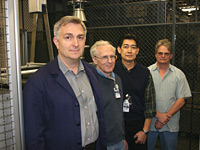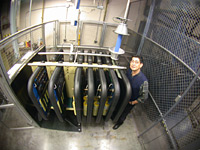Director's Corner
1 March 2007
 Barry Barish |
 Ray Larsen |
ILC Baseline Alternative: The Marx Modulator
Today’s issue of ILC NewsLine features a special column written jointly by GDE Director Barry Barish and Ray Larsen of SLAC.
The release of the ILC Reference Design was a very important milestone. Yet, we have emphasised that it is really a snapshot of the ILC design. It is not the ILC we will build, and it will evolve significantly as we move forward. In our Baseline Configuration Document (BCD) that we published more than a year ago, we documented a set of alternatives to the baseline. The alternatives, though not mature enough to be chosen over the baseline, potentially could improve the performance, or reduce cost or risk. We are pursuing a vigorous R&D program to develop the alternatives, and this past week we accomplished a notable success when the Marx Modulator passed a major milestone.
The most expensive part of the ILC Baseline RF power system are 646 pulse modulators that convert AC line power into high voltage pulses to drive each 10 MW peak power klystron. Historically, modulators have been unreliable due to relatively short-lived gas tube switches. New solid state switches have now come to the forefront of commercial power electronics, enabling a new generation of modulators with higher reliability and efficiency.
 Greg Leyh, Piotr Bloom, Alfred Viceral and Jeff Olsen of the SLAC team. |
 The Marx Modulator Test Facility at SLAC. |
In 2004 the ILC team at SLAC proposed development of an Alternate Conceptual Design to capture these advantages along with a significantly lower cost. The key was a Marx design that could output high voltage DC directly without a large, heavy and expensive voltage step-up transformer. The Marx is basically 12 storage capacitor “cells” charged to 10 kV in parallel and then suddenly switched to a series configuration to output 120 kV at the top cell. Besides eliminating the transformer, switching at high voltage and low current lowers I2R power losses dramatically. In addition, its modular plug-in board design facilitates a redundant architecture so components on the cells or entire cells can fail without interrupting operation. Finally, the unit is air cooled inside a tight enclosure which is easy to access for quick repair. The Marx is predicted to cost less than half the current design with higher wall-plug efficiency and lower frequency of machine interruption.
The innovative design, the brainchild of Project Engineer Greg Leyh, was derived from an earlier 500 kV short pulse prototype he built for the Next Linear Collider (the ILC in pre-GDE days). Engineering support includes Piotr Blum, Jeff Olsen, Alfred Viceral, Richard Cassel and group, Craig Brooksby (NSTec/LLNL) and Ed Cook (LLNL); while Keith Jobe and Craig Burkhart help resolve safety issues. Ray Larsen is the Project Manager.
The first prototype achieved its design voltage of 120 kV on 20 February 2007, which signaled that the highest technical risk of HV breakdown can be managed. In addition, a basic capacitor droop compensation scheme was demonstrated. Plans call to next test the thermal design in 2000 hours of sustained full power running.
The Marx design includes intelligent diagnostics on every cell, and the prototype system is running. Eventually it will be possible to observe temperatures, interlock settings and margins, and fast pulse waveforms on every cell in the ILC Control Room. Independent timing and delay controls to each cell are used to compensate output waveform flatness.
The ILC R&D program justifies itself to a large extent on its impact beyond furthering the project. In addition to developing the forward looking superconducting RF accelerator technology, we are developing many other important technologies. For example, high speed solid state switch technology is revolutionising the power supply business at many levels, from board level to multi-kW converters, resulting in extremely compact power systems of low weight. The transformerless Marx design will impact industry in specialty areas such as military radar systems, where a prototype has been built, and also in retrofitting many old designs still based on gas tubes.
The Marx modulator will need to pass further hurdles before it can be incorporated into the ILC baseline. In any case, we are on track toward incorporating the Marx, and are very happy to acknowledge reaching this important milestone, and we congratulate the team at SLAC who are pursuing this development.
-- Barry Barish and Ray Larsen